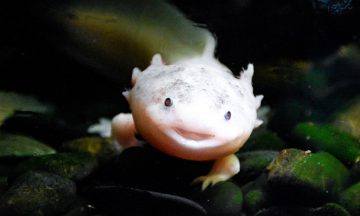Scott Sayare in Aeon:
 In its most common form, which scientists call the white mutant, the axolotl resembles what the translucid foetus of a cross between an otter and a shortfin eel might look like. On the internet, it is celebrated for its anthropoid smile; in Mexico, where the Aztecs once hailed as it as a godly incarnation, it is an insult to say that someone looks like one. Behind its blunt and flattened head extends a distended torso resolving into a long, ichthyic tail. The axolotl can grow to nearly a foot in length; four tiny legs dangle off its body like evolutionary afterthoughts. It wears a collar of what seem to be red feathers behind each cheek, and these ciliated gill stalks float and tremble and gently splay in the water, like the plumage in a burlesque fan. They grow back if you cut them off, too. Precisely how the animal accomplishes this, or any of its feats of regrowth, is not well understood.
In its most common form, which scientists call the white mutant, the axolotl resembles what the translucid foetus of a cross between an otter and a shortfin eel might look like. On the internet, it is celebrated for its anthropoid smile; in Mexico, where the Aztecs once hailed as it as a godly incarnation, it is an insult to say that someone looks like one. Behind its blunt and flattened head extends a distended torso resolving into a long, ichthyic tail. The axolotl can grow to nearly a foot in length; four tiny legs dangle off its body like evolutionary afterthoughts. It wears a collar of what seem to be red feathers behind each cheek, and these ciliated gill stalks float and tremble and gently splay in the water, like the plumage in a burlesque fan. They grow back if you cut them off, too. Precisely how the animal accomplishes this, or any of its feats of regrowth, is not well understood.
Like the axolotl, our evolutionary forebears seem to have been regenerators, and human children can in fact still regrow the tips of their fingers above the final joint, but that’s the only complex regeneration we’re known to do. We are, instead, a species that scars. Why our lineage lost its regenerative birthright is unclear. From our present evolutionary vantage point, however, it might be nice to get back what we lost. Amputees could recover their limbs; paralytics could walk; degeneration and decline of all sorts might be reversed. Last year, after a long effort by an international consortium, the axolotl genome – 10 times the length of the human genome – was finally sequenced. In early 2019, it was mapped onto chromosomes by a team at the University of Kentucky. (It is, for the moment, the longest genome ever sequenced by far.) Jessica Whited, who heads an axolotl lab at Harvard Medical School, told me that, for those who hope to someday make regeneration available to human medicine, the axolotl is a perfect instruction manual. Its language simply needs decoding.
More here.
